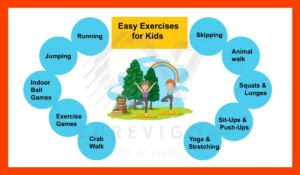Keep your children healthy and active with ease! Discover ten simple and fun exercises for physical activity. Transform fitness into a delightful journey for your kids!
Contents
- 1 10 Easy Exercises for Kids
- 2 Running
- 3 Jumping
- 4 Indoor Ball Games
- 5 Exercise Games
- 6 Skipping
- 7 Crab Walk
- 8 Frog or Bear Walk
- 9 Squats and Lunges
- 10 Sit-Ups and Push-Ups
- 11 Yoga and Stretching
- 12 Benefits of Family Fitness
- 12.1 Importance of Exercising Together as a Family
- 12.2 How Family Fitness Can Strengthen Bonds
- 12.3 FAQs on Easy Exercises
- 12.3.1 Q. What are simple physical exercises for kids?
- 12.3.2 Q. How can I make exercise fun for my kids?
- 12.3.3 Q. What exercise should a 10-year-old do?
- 12.3.4 Q. What is a good workout for kids?
- 12.3.5 Q. Can a 12-year-old work out?
- 12.3.6 Q. How can I lose belly fat as a kid?
- 12.3.7 Q. How do I get ripped at 11 years old?
- 12.4 Conclusion on Easy Exercises
- 13 Click for more articles about Health & Wellness.
10 Easy Exercises for Kids
Keeping kids active is more important than ever, especially with the increasing time spent on screens and indoors. Physical activity helps with physical health and boosts mental well-being, social skills, and happiness. Let’s dive into 10 easy exercises that are perfect for kids and sure to bring fun and fitness into their daily routines.

Running
Running is one of the simplest yet most effective exercises for kids. It helps build strong bones, improves cardiovascular health, and enhances coordination.
Benefits of Running
Running aids in developing endurance in children, strengthens their muscles, and promotes heart health. It is an excellent activity for expelling surplus energy and can be practiced anywhere.
Tips for Making Running Fun
Transform running into a playful activity by engaging in games like tag, setting up relay races, or designing obstacle courses. Establishing small milestones and commemorating accomplishments can help maintain children’s motivation.
Jumping
Jumping is fantastic for improving coordination and leg strength. It’s an activity that kids naturally enjoy and can do indoors or outdoors.
Why Jumping is Great for Kids
Jumping increases bone density, improves balance, and boosts cardiovascular health. It also helps in developing muscle strength and endurance.
Fun Jumping Activities
Consider playing hopscotch, skipping rope, or bouncing on a trampoline. You can also devise a straightforward jumping game using household objects like cushions or compact boxes.
Indoor Ball Games
Ball games are perfect for developing hand-eye coordination and teamwork skills. They are versatile and can be adapted for indoor play.
Benefits of Indoor Ball Games
Playing ball games enhances motor skills, improves reflexes, and encourages social interaction. It’s also a great way to teach kids about teamwork and sportsmanship.
Popular Indoor Ball Games
Excellent games include indoor soccer, balloon volleyball, and soft dodgeball. These can be easily set up in a living room or a play area.
Exercise Games
Exercise games combine physical activity with fun, making it easier for kids to stay engaged and active.
What are Exercise Games?
Exercise games are activities designed to get kids moving while having fun. They can involve a variety of movements, such as jumping, running, and balancing.
Examples of Exercise Games
Simon Says with a fitness twist, freeze dance, and obstacle courses are great examples. These games keep kids entertained while ensuring they get plenty of exercise.
Skipping
Skipping is an excellent cardiovascular exercise, whether with a rope or in place. It enhances coordination and agility.
Benefits of Skipping
Skipping burns calories strengthens the heart, and improves muscle tone. It’s also a portable exercise that can be done anywhere.
Fun Ways to Skip
Incorporate variations such as double-unders, criss-cross, or skipping in rhythm with music. Additionally, you can organize skipping competitions to determine who can skip the longest or the quickest.
Crab Walk
The crab walk is a fun and challenging exercise that engages multiple muscle groups.
How to Do the Crab Walk
Sit on the floor, place your hands behind you, lift your hips off the ground, and walk backward like a crab. It’s a fantastic way to build upper body strength.
Benefits of the Crab Walk
These exercises strengthen the arms, shoulders, core, and legs, enhancing coordination and balance.
Frog or Bear Walk
Animal walks (Frog Walk or Bear Walk) are enjoyable and beneficial for enhancing strength and mobility.
Explanation of the Frog or Bear Walk
For the frog, walk, squat down, place your hands on the ground, and jump forward like a frog. For the bear walk, get on all fours and walk forward. Both mimic animal movements and are great fun for kids.
Benefits of These Exercises
These walking exercises enhance strength, agility, and coordination, offering a comprehensive full-body workout and improved flexibility.
Squats and Lunges
These classic exercises are excellent for building leg strength and stability. For more advanced exercises, have children use dumbbells or medicine balls. They can also use resistance bands or elastic tubing to provide additional resistance.
Importance of Squats and Lunges
Squats and lunges target the lower body muscles, including the quads, hamstrings, and glutes. They are fundamental exercises for developing strength and balance.
Proper Form and Variations
Ensure kids keep their backs straight and knees aligned with their toes. Try variations like jumping squats, side lunges, or lunge walks to keep it interesting.
Sit-Ups and Push-Ups
Bodyweight exercises like sit-ups and push-ups are perfect for building core and upper body strength. Depending on the child’s age, these exercises can be modified to be more accessible or challenging. Start slow and gradually increase the intensity as the child gets more comfortable.
Benefits of Sit-Ups and Push-Ups
Sit-ups strengthen the abdominal muscles, while push-ups build upper body strength. Both exercises also improve endurance and posture.
Fun Ways to Incorporate These Exercises
To make these exercises more engaging, create challenges or use timed intervals. Incorporate them into a circuit with other fun activities to keep kids motivated.
Yoga and Stretching
Yoga and stretching are vital in enhancing flexibility, promoting relaxation, and sharpening mental focus.
Importance of Flexibility and Mindfulness
Yoga helps improve flexibility, balance, and concentration. It also introduces kids to mindfulness and relaxation techniques, which can reduce stress and anxiety.
Kid-Friendly Yoga Poses and Stretches
Try poses like the cat-cow, tree pose, and child’s pose. Incorporate stretches that focus on different muscle groups and encourage deep breathing to enhance relaxation.
Benefits of Family Fitness
Exercise together as a family has numerous benefits beyond physical health. It can help to build stronger relationships with family members, create a sense of unity, and foster healthy communication skills.
Importance of Exercising Together as a Family
Family fitness promotes bonding, encourages healthy habits, and provides mutual motivation. It sets a positive example for children and creates shared experiences.
How Family Fitness Can Strengthen Bonds
Participating in activities fosters communication, teamwork, and support. Exercising becomes more enjoyable and less chore when done with loved ones. Have fun, and encourage your kids to stay active and fit! Your efforts now will benefit them for years to come.
FAQs on Easy Exercises
Q. What are simple physical exercises for kids?
Simple physical exercises for kids include running, jumping, skipping, playing ball games, and walking animals like crabs or bears. These activities are easy to set up, require little to no equipment, and can be done indoors or outdoors. They help improve coordination, strength, and cardiovascular health while keeping kids entertained and active.
Q. How can I make exercise fun for my kids?
Integrating games, challenges, and family-oriented activities can make exercising more enjoyable. Utilizing music, designing obstacle courses, and acknowledging accomplishments are great ways to motivate everyone.
Q. What exercise should a 10-year-old do?
A 10-year-old should engage in exercises that promote overall fitness and are fun. Activities such as running, jumping rope, playing soccer or basketball, swimming, cycling, and participating in exercise games like tag or relay races are excellent choices. Additionally, incorporating bodyweight exercises like squats, lunges, sit-ups, and push-ups can help build strength and endurance.
Q. What is a good workout for kids?
A good workout for kids includes cardiovascular, strength, and flexibility exercises. For example, a 30-minute session could consist of:
- 5 minutes of warm-up (jumping jacks, stretching)
- 10 minutes of running or playing a ball game
- 5 minutes of bodyweight exercises (squats, push-ups, sit-ups)
- 5 minutes of fun activities like skipping or an obstacle course
- 5 minutes of cool-down (gentle stretching, deep breathing)
The above combination ensures a balanced workout that keeps kids engaged and moving.
Q. Can a 12-year-old work out?
Yes, a 12-year-old can work, and it’s highly beneficial for their health and development. They should focus on safe and age-appropriate activities, such as playing sports, swimming, cycling, and participating in structured exercise routines, including bodyweight, stretching, and aerobic activities. Proper supervision and guidance are essential to prevent injury and promote good habits.
Q. How can I lose belly fat as a kid?
To lose belly fat as a kid, focus on regular physical activity and healthy eating habits. Engage in daily exercises like running, playing sports, jumping rope, and bodyweight exercises such as squats and sit-ups. Additionally, eating a balanced diet rich in fruits, vegetables, whole grains, and lean proteins while limiting sugary snacks and beverages is crucial. Staying active and making healthy food choices will help reduce belly fat and improve overall health.
Q. How do I get ripped at 11 years old?
Getting “ripped” or developing defined muscles at 11 years old should be cautiously approached. Focusing on overall fitness and health is essential rather than just muscle definition. Engage in regular physical activities like sports, running, swimming, and bodyweight exercises such as push-ups, squats, and lunges. Additionally, maintain a balanced diet rich in nutrients. Emphasize proper form and safety to avoid injury, and remember that muscle development will come naturally with regular exercise and healthy habits over time.
Conclusion on Easy Exercises
Incorporating these easy exercises into your kids’ daily routine can significantly enhance their physical and mental well-being. From running and jumping to yoga and family fitness, these activities are designed to be fun, engaging, and beneficial. So, lace up those sneakers and get moving!
Click for more articles about Health & Wellness.
You may like to read the following article:
Best Ways to Preserve Your Child’s Emotional Well-Being: Avoiding Negative Communication










